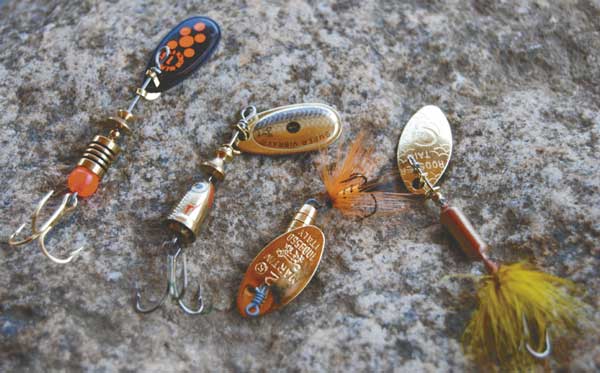
Spinner fishing is a good alternative to fly fishing when trout aren’t rising to a hatch or snatching a nymph. Often a spinner will elicit a strike even when trout aren’t hitting live bait. I’ve seen many good spin fishers work a section of stream and catch trout after trout after bait fishers had given up.
Trout are attracted more by the vibrations a spinner emits and the flash of the spinner’s blade than by anything the lure imitates. The primary appeal of spinner fishing is anglers can fish with the same lure all day long.
I seldom use more than four types of spinners — a plain Mepps Aglia, a black or white Rooster Tail, a plain Blue Fox and a yellow Panther Martin with black dots. If I don’t catch a trout with one of these lures, the fish aren’t hitting.
One rule of thumb for spinner fishing is to use a silver spinner blade for dingy water and a gold blade for clear water. But it’s not a hard-and-fast rule.
As for equipment, I use either an ultra-light or light spinning rod and reel for small streams or a medium-light rod and reel for larger streams such as the Tuckasegee, French Broad, the lower South Toe or lower Oconaluftee River. Two- to 4-pound test line works well for ultra-light and light rigs, and 4- to 6-pound test line works well with a medium-light rig.
Anglers may fish upstream or downstream because casts usually are angled across the water flow toward the bank.
When I cast, I let the spinner sink then begin my retrieve, alternating between fast and slow. Giving a spinner an occasional twitch often will attract a quick strike if a regular retrieve doesn’t work.
Spinners can be used at deep pools, runs, riffles, flat water and shallow water. At small, brushy streams where fly-fishing is next to impossible, anglers may flip a spinner underneath low-hanging laurel branches and other brushy growth to reach a trout’s hiding place.
At big streams, they may make long casts and cover more water in less time.
Spinners work particularly well after a rain shower muddies a stream. A trout might not be able to spot a fly in high, dingy water, but it can hear or sense a spinner cutting through stained water.
Unlike fishing with live bait, anglers may can use a spinner at wild and hatchery-supported waters. If anglers fish wild-trout or delayed-harvest waters, make certain the spinner has only one hook.
You may have to snip off hooks to make a lure legal since most spinners come with treble hooks.
Spinning gear can be used to fish large fly streamers, such as a Muddler Minnow, Zonker and Woolly Booger or large nymphs such as a rubber-legged Girdlebug and Giant Stone. Anglers may have to pinch on a little lead for casting purposes.
When using streamers and nymphs, a fisher should set the hook as soon as he feels a hit. It takes only a millisecond for a trout to determine if a fly is real or artificial.
Anglers may even use a spinning rig with dry flies by attaching a bobber to the line. One bobber that works particularly well is a Torpedo Bubble, a tear-shaped plastic bobber with eyelets at both ends. Attach the big end to the regular line, tie on a 3- to 5-foot section of leader to the small end, then attach the fly.
The bubble keeps dry flies afloat almost as well as a floating fly line. By adding a little weight and varying the length of the leader, anglers may fish a nymph at the bottom or just below the surface. If you’re unable to find a Torpedo Bubble, a small bobber also will work, although not as well.
The trick to casting with a Torpedo Bubble (or other bobbers) is to stop the cast about 2 feet above the water. Although the bubble will make a slight splash, it will place the leader and fly flat and straight on the water.
During a caddis hatch, cast the bubble and fly downstream and work it back upstream, imitating the way a caddis swims.
The bubble should keep the fly shallow enough so the angler can see when a trout strikes. The bubble-fishing technique is useful when fishing remote streams and fishers don’t want to carry two rods.
Other spin fishing tips include:
• When fishing hard-to-reach pockets created by log jams, brush, overhanging limbs or undercut banks, cast short of the pocket, release line and let the current sink the lure before starting a retrieve.
• Work a spinning lure through a riffle early in the morning or late in the evening to catch feeding trout.
Cast to the head of the riffle and quickly retrieve the lure through the riffle. If you don’t get a strike after three or four casts, leave that area and try a different one.
• To avoid spooking trout, work the water closest to you first.
• For small streams, use a 1/16- or 1/8-ounce spinner. For large streamers, ¼-ounce or larger spinners can be used.
Trout rarely swallow spinning lures. Fish usually are hooked in the lip, making catch-and-release fairly simple, even with treble hooks.
Consider spinner fishing a step up from bait fishing and a good alternative to fly fishing, especially when trout get the frustrating condition known as “lockjaw.”
June fly patterns include:
• Flies with a little yellow in them are preferred patterns.
• For dry-fly fishing, try Little Yellow Stone, Light Cahill, Light Caddis, Golden Stone, yellow May Fly, yellow Palmer, and female Adams with the yolk sac.
• Suggested nymph patterns are Yellow Stone, Tellico, Inchworm and Yellowhammer.




Be the first to comment